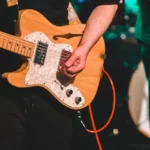Hands. What would guitarists do without them?
They are the tools that help bring music to our ears.
What’s interesting is that no tool functions the same.
For some guitarists, the left hand is the one that adapts to the fret, creating chords.
For others, the right hand is the one that does the job.
More interesting is the fact that the dominant hand won’t always be the one that decides the fate of the guitarist.
What does that mean? That a left-handed person can play with a right-handed guitar?
Yes, you can play a right-handed guitar even if you are a left-handed person. You can leave the guitar as is, and play with the “standard” string order, or restring the guitar to emulate a left-handed string order. Handedness won’t matter in the end, as long as you start early and stick to one decision only.
If you want to find out which way is the right way for you, then you are in the right place.
Keep on reading, cause maybe the right way for you will be the left.
How to know if you are left-handed for guitar?
Most probably, you’ll know whether you are a left-handed guitarist or not if you are already left-handed in everyday life.
Just as right-handed people should go for right-handed guitars, left-handed dominants should pick a left-handed guitar.
The main reason is that in most cases, the dominant hand is the one that strums the strings. This is because of a variety of reasons.
For example, the dominant hand is quicker for pickling notes.
What is more, is easier for playing blindly. That is to say, without looking at the picking hand (dominant hand).
Generally, this is going to be the norm, but remember, there are exceptions.
What if you are ambidextrous?
What if despite all odds, you still want to play with a right-handed instrument?
Should you force yourself to learn how to play right-handed?
The only thing you should force yourself to do is practice.
This is interesting because in the long run, picking a right-handed or left-handed guitar won’t matter at all.
Unless of course, you don’t practice.
What I’m trying to say is that if you are a left-hand dominant, you shouldn’t condition yourself to a left-handed guitar just because.
You CAN make right-handed instruments your default option… but should you?
You should, but only if you are a beginner.
Otherwise, rewiring your playing style will be hard and tiresome (not to mention, in some cases impossible).
The main reason you would want to switch is both money and availability.
What do I mean by that?
I mean that is easier to get a right-handed guitar on any store. They are more available.
So, if left-handed guitars are more difficult to obtain, then they are also a bit more expensive.
As I usually say, the final decision is yours.
However, why not take a look at more details before running and purchasing anything?
Alternatives to play a right-handed guitar as a left-handed
You went to the store and the only left guitar you found was a Hello Kitty Model.
Just your luck!
It seems that you’ll have to get by with the right-handed guitar you had at the basement.
There are two ways in which you can profit from this.
Learn how to play with standard string order
This is a straightforward alternative: Just hold the guitar left-handed, but leave its strings in the “standard” order.
Now you will have the strings ordered from thinnest to thickest, and this will force you to bend the highest strings downwards, instead of upwards as right-handed players do.
But many players pulled this off through the years.
Examples of this alternative are:
- Glen Burtnik (Styx)
- Buddy Miles
- Dick Dale
- Albert King
It looks like this:
Restring your guitar
See those six strings that go from the headstock to the bridge? Good, take them all out.
Now rearrange the order. Put them backward.
The string sequence should look exactly as when the guitar was in a right-handed position.
This way, you’ll play without much difficulty, and you will be bending upwards, most likely, on the thinner strings.
There’s only one setback with this system: controls will be backward, and not in a very ergonomic position.
Of course, you’ll eventually get used to it and forget about that being an issue.
Some famous guitarists play (or played) this way:
- Jimi Hendrix
- Billy Ray Cyrus
- Kurt Cobain (Nirvana)
- Tony Iommi (Black Sabbath)
- Zacky Vengeance (Avenged Sevenfold)
- Tim Armstrong (Rancid)
- Gregor Mackintosh (Paradise Lost)
Bassists are not out of this list, with Paul McCartney and Paul Gray (Slipknot) being two of the most memorable examples.
Take a look at it:
Main difference between a right-handed and a left-handed guitar
Left-handed guitars mirror their right-handed versions.
If you were to see both guitars standing vertically in front of you, you’ll notice the following:
Right-handed guitars have the thickest string on the left side.
On the contrary, left-handed guitars have their thickest string on the right side.
The same applies to the fretboards side markers.
A literal mirror effect.
In addition, a more obvious place to spot the difference is their pickguard.
If a guitar happens to have a pickguard, it will be in its left part for lefties.
Right-handed guitars have their pickguards on their right side.
Why would a left-handed want to play right-handed guitars?
As I mentioned earlier in this article, the main reason to make right-handed guitars a default option is their availability.
Unfortunately, money can be a drawback.
Standard guitars tend to be cheaper because producing left-handed guitars cost more money and more time.
This is because they are not mass-produced. At least, not as common as standard guitars.
However, even though you’ve got the money to buy a more expensive guitar, you’ll find more difficulties.
If they are produced in reduced numbers, then they are found in fewer stores.
A detail that seems to sneak away from this concern, is the fact that availability doesn’t just apply to stores.
Go to a party at your best friend’s house. Suddenly, he takes out his guitar.
You want to play and to impress people but hold on a second! You are lefty, and that guitar is for right-handed people!
The same issue applies to a camp or a day at the beach.
Wherever you go, you’ll most probably find right-handed guitars.
Sorry.
Conclusion
Although some musicians started with one hand and then switched to the other, I highly recommend you not to follow this advice.
Instead, stick either with one of your hands from the very beginning, then push your abilities to the limit.
Don’t be afraid.
The position won’t define your skills. You are the one in charge of that.
All you have to do is to practice and enjoy the process.

Hello there, my name is Ramiro and I’ve been playing guitar for almost 20 years. I’m obsessed with everything gear-related and I thought it might be worth sharing it. From guitars, pedals, amps, and synths to studio gear and production tips, I hope you find what I post here useful, and I’ll try my best to keep it entertaining also.





